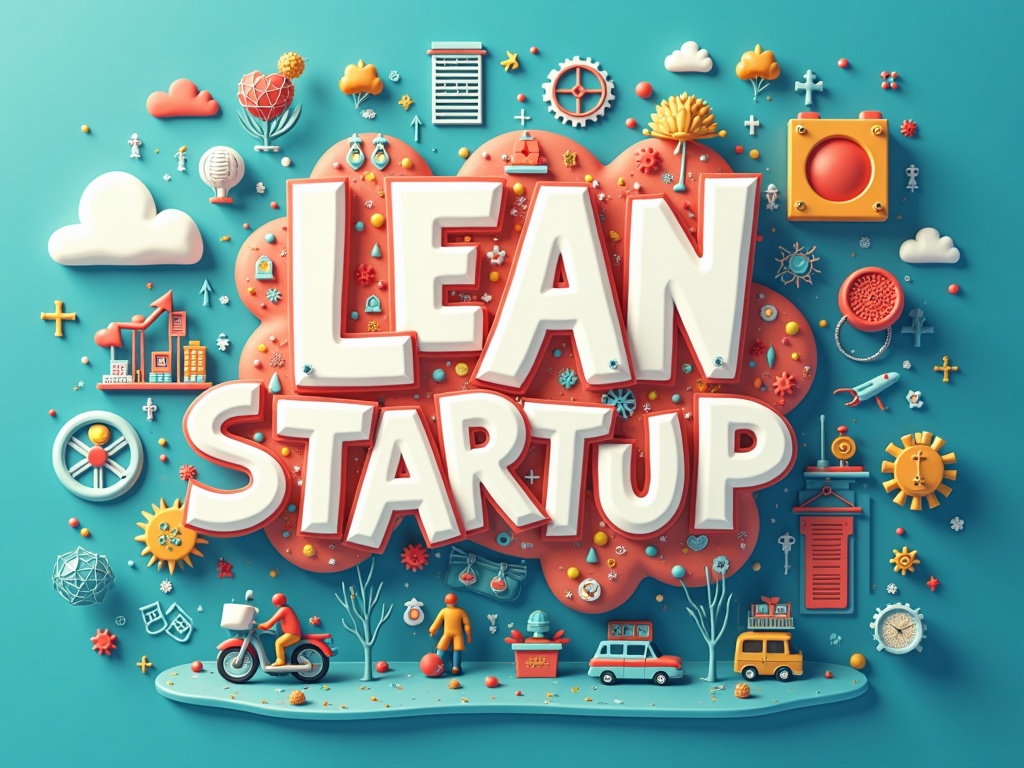Lean Startup Methodology Explained: Build, Measure, Learn Your Way to Success
Imagine launching a business, pouring your heart and soul (and savings!) into a product, only to discover nobody wants it. Ouch. That's the fear that fuels the lean startup movement—a methodology designed to minimize waste and maximize learning, ensuring you build something people actually desire. This isn't your grandpa's business plan; it's a dynamic, iterative approach perfectly suited for the fast-paced world of modern entrepreneurship.
What is the Lean Startup Methodology?
Coined by Eric Ries in his book, The Lean Startup, the methodology is about building companies and launching new products more effectively. It's essentially a scientific approach to entrepreneurship, emphasizing validated learning, rapid iteration, and customer feedback. Instead of spending months (or even years) developing a perfect product behind closed doors, lean startups launch a Minimum Viable Product (MVP) early, gather data, and adapt based on real-world feedback. Think of it as a continuous loop of build, measure, and learn.
The Core Principles
At its heart, the Lean Startup methodology rests on a few key principles:
**Validated Learning:It's not enough to just build something. You need to prove that your assumptions about your customers and your business model are correct. This is done through experimentation and data analysis.
**Build-Measure-Learn Loop:This is the engine that drives the lean startup. You build a minimal product, measure how customers react to it, and learn from the data to improve your next iteration.
**Minimum Viable Product (MVP):The MVP is the version of your product with just enough features to attract early-adopter customers and validate your product idea early in the product development cycle.
**Pivot or Persevere:Based on the data you collect, you need to decide whether to stick with your current strategy (persevere) or make a fundamental change in direction (pivot).
**Innovation Accounting:This is a way of measuring progress in a startup, focusing on metrics that are actionable, accessible, and auditable. Traditional accounting metrics can be misleading in the early stages of a startup.
The Build-Measure-Learn Feedback Loop: A Deeper Dive
The soul of the lean startup lies in its relentless pursuit of knowledge via the build-measure-learn feedback loop:
Build: Creating the Minimum Viable Product (MVP)
Forget perfection. The initial build phase is about speed and efficiency. Your aim is to create a Minimum Viable Product (MVP) – a version of your product with just enough core features to attract early adopters and validate your core assumptions. Think of it as a prototype, a beta version, or even a smoke test where you simulate the product experience without building the entire thing. The MVP isn't about cutting corners; it's about identifying and testing the riskiest assumptions first. What is the one thing that *mustbe true for your business to succeed? Focus on building a product that tests that assumption.
Examples of MVPs include:
**Dropbox:They started with a simple video demonstrating how their file-syncing service would work. This allowed them to gauge interest before writing a single line of code.
**Zappos:Instead of building a massive inventory and website, the founder simply took pictures of shoes at local stores and posted them online. When someone placed an order, he bought the shoes from the store and shipped them directly to the customer, validating the demand for online shoe sales.
**Buffer:They started with a simple landing page explaining their idea for a social media scheduling tool. They then tracked how many people signed up to learn more, validating interest before building the actual product.
Measure: Gathering Actionable Data
Once your MVP is launched, it's time to gather data. But not just any data. You need actionable metrics that tell you something meaningful about how customers are using your product and what they think of it. This goes beyond vanity metrics like total website visits. Focus on metrics that drive decisions and provide insights for improvement.
Key metrics to track might include:
**Conversion Rates:What percentage of visitors sign up for a free trial or purchase your product?
**Customer Acquisition Cost (CAC):How much does it cost to acquire a new customer?
**Customer Lifetime Value (CLTV):How much revenue will you generate from a customer over their lifetime?
**Engagement Metrics:How frequently and actively are customers using your product?
**Churn Rate:What percentage of customers stop using your product over a given period?
Tools like Google Analytics, Mixpanel, and Amplitude can help you track these metrics. But remember, data is only valuable if you use it to make informed decisions.
Learn: Iterating and Adapting
The final step in the loop is learning. Analyze the data you've collected and identify patterns and insights. What's working well? What's not? Are your initial assumptions being validated? Based on your findings, you need to decide whether to persevere with your current strategy or pivot to a new one.
Pivoting doesn't mean giving up; it means changing direction based on evidence. There are several types of pivots, including:
**Zoom-in Pivot:Focusing on a single feature that resonates with customers and making it the core of your product.
**Zoom-out Pivot:Expanding your product to include additional features in response to customer demand.
**Customer Segment Pivot:Targeting a different customer segment based on what you've learned.
**Platform Pivot:Shifting from an application to a platform, or vice versa.
**Business Architecture Pivot:Switching from a high-margin, low-volume business model to a low-margin, high-volume model, or vice versa.
Benefits of Using the Lean Startup Methodology
Why embrace the lean startup approach? The benefits are compelling:
**Reduced Waste:By focusing on validated learning and avoiding unnecessary features, you minimize wasted time, effort, and resources.
**Faster Time to Market:The rapid iteration cycle allows you to get your product to market faster and start generating revenue sooner.
**Increased Customer Satisfaction:By continuously gathering and incorporating customer feedback, you build a product that truly meets their needs.
**Reduced Risk:By testing your assumptions early and often, you reduce the risk of building a product that nobody wants.
**Improved Innovation:The lean startup methodology encourages experimentation and creativity, leading to more innovative products and services.
**Adaptability and Resilience:The constant feedback loop allows for rapid adaptation to changing market conditions and customer needs, making you more resilient in the long run.
Common Mistakes to Avoid
While the Lean Startup methodology is powerful, it's not foolproof. Here are some common mistakes to avoid:
**Building an MVP That's Too Complex:The MVP should be *minimal*. Avoid adding unnecessary features that don't directly test your core assumptions.
**Not Talking to Customers:Data is important, but it's no substitute for direct customer interaction. Talk to your users, understand their needs, and get their feedback on your product.
**Ignoring the Data:Don't let your biases cloud your judgment. Be willing to change your strategy based on the data, even if it contradicts your initial assumptions.
**Pivoting Too Quickly (or Not Quickly Enough):It's important to give your initial strategy a fair chance to succeed, but don't be afraid to pivot if the data suggests it's necessary.
**Focusing on Vanity Metrics:Track the metrics that truly matter to your business, such as conversion rates, customer acquisition cost, and customer lifetime value.
**Treating the MVP as a One-Time Thing:The MVP is just the starting point. You should continue to iterate and improve your product based on customer feedback.
Examples of Successful Lean Startups
Numerous companies have used the Lean Startup methodology to achieve success. Here are a few notable examples:
**Dropbox:As mentioned earlier, they used a simple video to validate the demand for their file-syncing service.
**Airbnb:They started by renting out air mattresses in their apartment to attendees of a local conference, validating the idea that people would be willing to stay in someone else's home.
**Wealthfront:They built a simple prototype to test the concept of automated investment management before building their full-fledged platform.
**IMVU:They focused on building a product with a very specific user in mind and continuously iterated based on their feedback.
**Grokker:They built a series of targeted, niche online workout programs based on validated demand, before investing heavily in building a broader platform.
Implementing Lean Startup Principles: A Step-by-Step Guide
Ready to put the Lean Startup methodology into action? Here's a step-by-step guide:
1. **Identify Your Assumptions:What are the core beliefs you hold about your customer, the problem you're solving, and your proposed solution? Write them down.
2. **Prioritize Your Assumptions:Which assumptions are the riskiest? Focus on testing those first. If those assumptions are wrong, your entire business could fail.
3. **Design Experiments:Create experiments to test your assumptions. This might involve building a Minimum Viable Product (MVP), conducting customer interviews, or running A/B tests.
4. **Build Your MVP:Create a *minimalproduct that allows you to test your most critical assumptions. Remember, it doesn't have to be perfect.
5. **Measure Your Results:Track the right metrics and analyze the data to see if your assumptions are being validated.
6. **Learn From Your Results:What did you learn from your experiment? Are your assumptions correct?
7. **Pivot or Persevere:Based on your findings, decide whether to stick with your current strategy or pivot to a new one.
8. **Repeat:Continue to iterate through the build-measure-learn feedback loop, continuously improving your product and your business model.
Conclusion: Embrace the Iterative Journey
The Lean Startup methodology isn't just a set of tactics; it's a mindset. It's about embracing uncertainty, prioritizing learning, and relentlessly focusing on customer needs. It’s an invaluable framework for any entrepreneur seeking to navigate the complexities of building a successful business in today's dynamic marketplace. Forget the rigid, outdated business plans of the past. Embrace the iterative journey, build something people love, and watch your startup thrive. The future belongs to those who learn the fastest.

